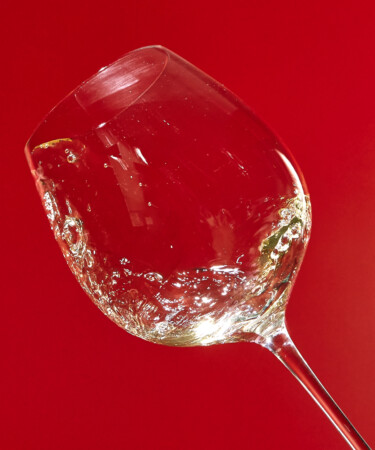Sometimes, the rituals surrounding wine tastings can feel like unnecessary fanfare that just prolong the time before you actually get to drink. That said, there are some extra steps that really can make a huge difference in the tasting experience. One such tradition is “seasoning” your wine glass.
VinePair tapped Damien Del Rio, the co-founder of New York-based Sauced wine bar, to share what it means to season a wine glass, and why you might want to add this step to your routine.
“Seasoning a glass is like giving your glass a little pre-game warm-up,” says Del Rio. “You take a bit of the wine you’re about to dive into and splash it around the glass to get those walls nice and coated.”
What does this accomplish? After going through the dishwasher or sitting on a dusty bar cart for a couple months, wine glasses might hold onto unpleasant aromas that can tarnish the tasting experience. Adding some wine to the glass and pouring it out can remove dust particles, soap residue, and start to fill the glass with the aroma of the wine.
“This little ritual cleans out any funky smells from soap or the cabinet, making sure nothing messes with the primo stuff you’re about to pour,” Del Rio says of seasoning. “It’s like setting the stage, making sure everything’s perfect for the main event. You’re tuning the glass to vibe perfectly with your wine, amplifying all those killer aromas.”
Let’s say you’re popping a juicy bottle of Cru Beaujolais to start the night. To prime your vessel, pour a small amount of that wine into the glass and slowly turn the glass sideways in a circular motion to make sure that the liquid makes contact with the entire interior of the glass. Then, you can pour the wine out — or sip it “if you’re feeling frisky,” Del Rio adds.
Drinkers can employ this technique for just about any occasion, but if you’re popping something that’s particularly expensive, that can be an especially good time to prime your glasses and make sure you’re getting the most out of the tasting experience.
“Got a bottle that costs more than your kicks? Season that glass and make every sip count,” Del Rio says. “You want to catch all those subtle hints like a pro.”
Del Rio also says that no matter what glassware you’re using, treating it with this method can up your wine game — unless it’s a red Solo cup.
“Seasoning isn’t picky about glass shapes, it’s all about the vibe you’re going for with your wine,” he says. “Whether you’re rocking tall, slim glasses for your whites or the big, bold bowls for your reds, giving them a quick swirl with wine before the main pour is like giving them a little blessing. It’s not about the shape; it’s about making sure whatever you’re pouring is hitting your lips at its best.”
